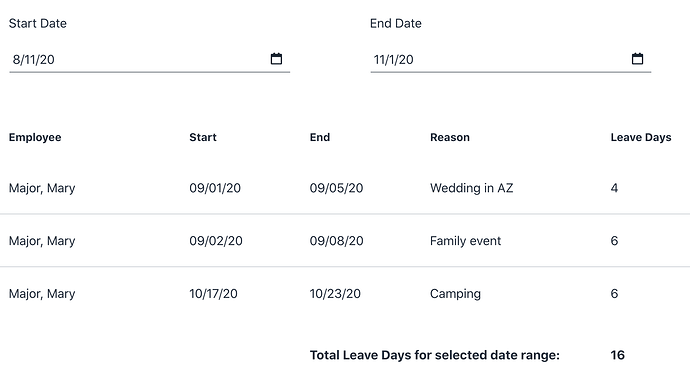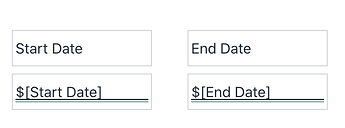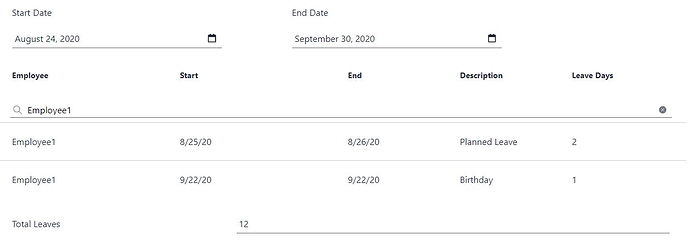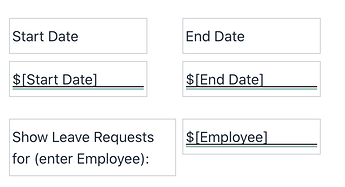I am creating an App for Leave approval.
I have create a table with headings"Employee" and "Manager and have formatted the columns as Contact.
I am not able to get the employee and manager to be listed from my team list. For example I have 4 team members, cannot get them to Employee ( cell ) and Manager ( cell ) relationship.
Hi @Vibh-178a, thanks for your post!
First off, a template that may be a good reference for you is our Time-Off Reporting template. In this template, you can see a table named "People" which stores the relationship of employee to manager, and the app demonstrates the functionality of what you'd like to do.
I would also suggest exploring personalization, which allows you to manage which information is displayed to users in the mobile and web apps. Here is an article with info on this: How to Personalize App Views.
In regards to adding contacts to your table, they will need to be contacts on your team.
If you do not see your team members available, perhaps they have not accepted the team invite. You can check the status of your team member invites and resend invites as needed on the Teams page in the left-hand panel of Honeycode.
Let me know if this helps.  Also, if you have any trouble adding contacts to your table, please let us know what exactly you are seeing.
Also, if you have any trouble adding contacts to your table, please let us know what exactly you are seeing.
Hi Thanks for the quick response, the issue has been resolved.
In the same Time-Off reporting scenario, I am trying to consolidate the number of leaves availed by an employee. Lets say I change the column Description to "Leave_Reason" and have a row list for the reasons. If an employee takes x number of leaves over a period of time, how do I calculate the the days a particular employee has taken leaves and the reasons.
Hi @Vibh-178a,
To achieve your ask, you can display the reasons and leave days in a selected time range with a filter, and add another column to your table, which will help calculate the total leave days for that time range.
I've created an example app that demonstrates this for you:
To set this up, create a screen with two fields that store variables of the start date and end date of what you would like to display.
Then create a column list object which displays the leave request info, such as the column for the leave reasons and total amount of days for the request. For the list data source, filter to only display the data from the provided start and end dates.
Filter formula in my example: =FILTER(Timeoff,"Timeoff[Start]>=$[Start Date] AND Timeoff[End]<=$[End Date]")
And for the total amount of leave days for that date range, add another field that calculates the sum.
Sum formula in my example: =SUM(FILTER(Timeoff,"Timeoff[Start]>=$[Start Date] AND Timeoff[End]<=$[End Date]")[Leave Days])
Hope this example helps. 

Hi Alyssa,
First of all thank you for the update, it works as desired for 1 employee for whom we have to calculate the total number of days. However if there are more employees, when I search by employee, the total leaves will still calculate for all the employees and not for the employee whom I am searching.
In the attached files, if you see Leavereq1 ( JPG file ) you can see the "Total Days" for all employees. However if I chose Employee1, Leavereq2 ( JPG fle ) will show "Total Days" for all employees calculated.
How do I get the "Total Days" for...
a. All Employees - Which is working as per your recommended approach.
b. Specific Employees - Need you inputs for this use case.
Regards
Hi @Vibh-178a,
You're welcome, I'm glad the first method was helpful for totals for all employees. 
If you'd like to set up a screen that specifies just specific employees, you can add another field to enter in a desired employee (Contact format) and add the variable to the filter and sum formulas accordingly.
So this is how I set it up:
I added a new field to store the employee name variable, which I set to the contact format.
Format of the field was specified in the properties (change to contact and I named the field $[Employee]).
And for the list formula, I updated the filter to also only filter by the employee (in addition to only entries in that range).
So the new formula for the list filter in my example is: =FILTER(Timeoff,"Timeoff[Start]>=$[Start Date] AND Timeoff[End]<=$[End Date] AND Timeoff[Employee]=$[Employee]")
And the new sum formula for the total leave days for the employee) in my example is: =SUM(FILTER(Timeoff,"Timeoff[Start]>=$[Start Date] AND Timeoff[End]<=$[End Date] AND Timeoff[Employee]=$[Employee]")[Leave Days])
Now you'll have a screen that shows the total leave days for just a specified employee, in a specified time range. 

Alyssa, Thanks again. This is indeed working as expected, appreciate your inputs.
This topic was automatically closed 3 days after the last reply. New replies are no longer allowed.











